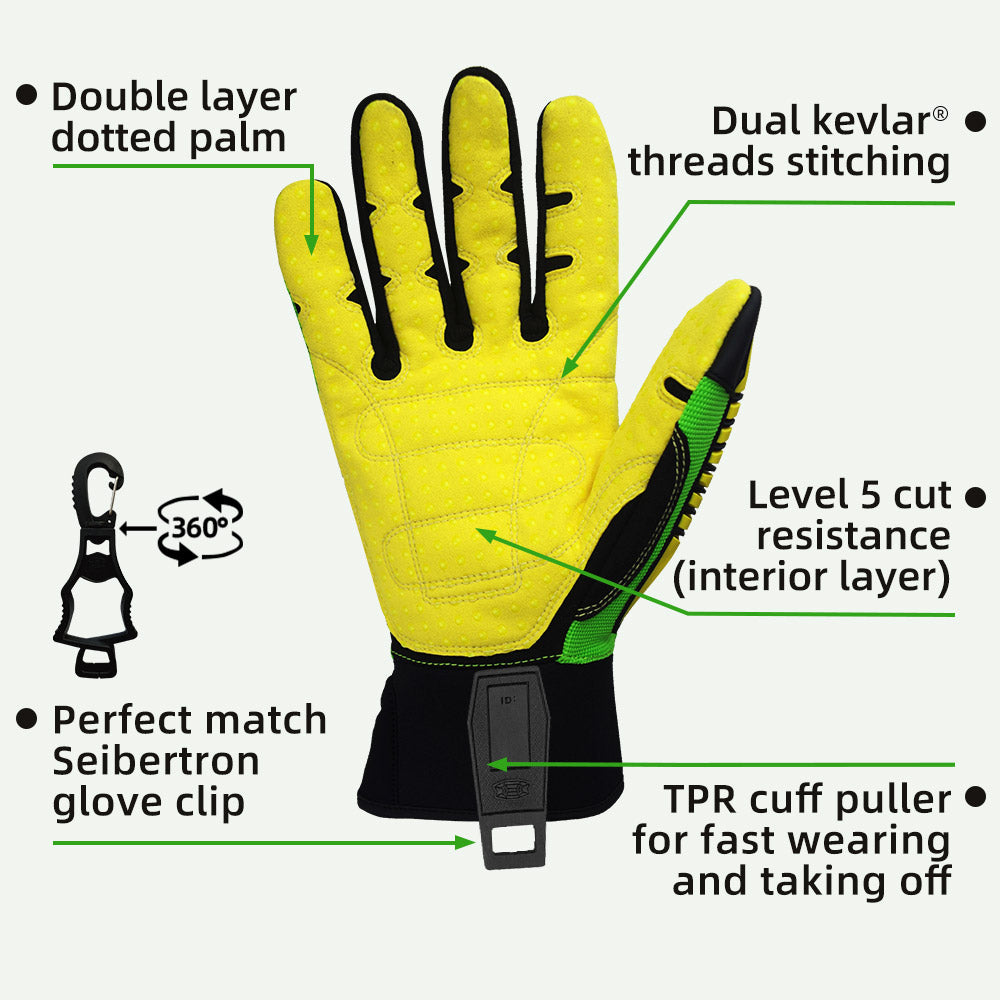EN 388 vs. ANSI 105: Understanding the Critical Differences in Safety Glove Standards
Discover how these essential safety standards protect workers across industries and why choosing the right certified gloves matters for workplace safety.
Introduction: The Vital Role of Hand Protection
In high-risk industries from construction to oil and gas operations, hand injuries remain among the most common workplace accidents. According to the U.S. Bureau of Labor Statistics, hand injuries account for nearly 25% of all workplace injuries. This alarming statistic underscores the critical importance of proper hand protection through certified safety gloves.
Two primary standards govern safety gloves globally: the European EN 388 and the American ANSI/ISEA 105. While both aim to protect workers from mechanical hazards, they differ significantly in testing methodologies, classification systems, and regional applications. Understanding these differences is essential for selecting the appropriate hand protection for your specific work environment.
At Seibertron, we engineer our safety gloves to meet or exceed both standards, providing comprehensive protection for workers worldwide. This guide will decode these essential safety standards, explain their testing requirements, and help you select the ideal gloves for your workplace hazards.
What is EN 388? The European Standard Explained
The EN 388 standard specifies requirements and testing methods for protective gloves against mechanical risks. Established by the European Committee for Standardization (CEN), this certification evaluates a glove's resistance to abrasion, cut by blade, tear, puncture, and impact.
Understanding the EN 388 Rating System
When you see the EN 388 pictogram on safety gloves, it's accompanied by a four- or five-digit code (like 3141X). Each digit represents the glove's performance level in a specific test:
| Position | Test | Performance Levels | Meaning |
|---|---|---|---|
| 1st Digit | Abrasion Resistance | 1-4 | Cycles required to abrade through material (higher = better) |
| 2nd Digit | Blade Cut Resistance | 1-5 | Index based on rotations needed to cut through material |
| 3rd Digit | Tear Resistance | 1-4 | Force required to tear the material (Newtons) |
| 4th Digit | Puncture Resistance | 1-4 | Force required to puncture material (Newtons) |
| 5th Digit (Optional) | Impact Protection (EN 13594) | P or F | P = Passed, F = Failed |
What Does "EN 388 Gloves Meaning" Actually Signify?
The term EN 388 gloves meaning refers to gloves that have been certified to protect against mechanical risks as defined by the European standard. When purchasing CE EN388 certified gloves, you're ensuring the product has undergone rigorous testing for:
- Abrasion resistance against rough surfaces
- Protection against cuts from sharp blades
- Resistance to tearing forces
- Puncture protection from sharp, pointed objects
- Impact protection (if marked with "P")
This certification is particularly valuable for industries like metalworking, glass handling, and construction where mechanical hazards are prevalent.
ANSI/ISEA 105: The American Standard for Hand Protection
Across the Atlantic, the American National Standard for Hand Protection (ANSI/ISEA 105) establishes classification criteria for gloves that protect against various workplace hazards. Developed through a partnership between the International Safety Equipment Association (ISEA) and the American National Standards Institute (ANSI), this standard provides a consistent, quantifiable means to compare glove performance.
The ANSI 105 Classification System
Unlike EN 388's sequential numbering, ANSI 105 uses a scale of 0-5 for each protection category, with 0 indicating no protection and 5 representing the highest level of protection. Key protection categories include:
| Protection Category | Levels | Testing Standard |
|---|---|---|
| Cut Resistance | A1-A9 (new) or 0-5 (legacy) | ASTM F2992 |
| Puncture Resistance | 0-5 | ASTM F1342 |
| Abrasion Resistance | 0-6 | ASTM D3389 |
| Tear Resistance | 0-5 | ASTM D2582 |
| Chemical Permeation | 0-6 | ASTM F739 |
This comprehensive approach allows ANSI 105 to cover a broader range of hazards than EN 388, including chemical and thermal risks. The standard is mandatory for gloves sold in the United States and widely recognized across North America.
Key Differences Between EN 388 and ANSI 105
EN 388: European Standard
- Primarily focuses on mechanical risks
- Uses a 4-5 digit coding system (e.g., 3141X)
- Cut test: Circular rotating blade (Coupe test)
- Impact protection included as optional test
- Mandatory in European Economic Area
- Performance levels: 1-5 for cut, 1-4 for others
- Test methods may be less sensitive for high-performance materials
ANSI/ISEA 105: American Standard
- Covers mechanical, chemical, and thermal risks
- Uses a 0-5 rating system for each category
- Cut test: TDM-100 machine with straight blade
- Separate standards for impact protection
- Required in the United States and Canada
- Performance levels: 0-5 for all categories
- More sensitive testing for high-cut-resistant materials
Critical Distinction: Cut Testing Methodology
The most significant difference between the standards lies in their approach to cut resistance testing:
EN 388 Cut Test: Uses a circular rotating blade that moves across the material under constant load (the Coupe test). This method can produce inconsistent results with highly cut-resistant materials, sometimes resulting in an "X" rating when the blade dulls prematurely.
ANSI 105 Cut Test: Employs the TDM-100 test (ASTM F2992) using a straight blade under increasing loads until cutting occurs. This method provides more consistent results for high-performance materials and better correlates with real-world cutting hazards.
Practical Implication: A glove rated Level 5 in ANSI 105 cut resistance typically offers superior protection to an EN 388 Level 5 glove. For high-risk cutting environments like metal fabrication or glass handling, look for gloves tested to both standards with high ratings in each.
Industry Applications: Matching Standards to Workplace Hazards
Oil and Gas Safety Gloves
In the oil and gas industry, workers face unique combinations of mechanical, chemical, and environmental hazards. Oil and Gas Safety Gloves must provide:
- High cut resistance (ANSI Level 4-5 / EN 388 Level 4-5)
- Puncture protection for handling sharp equipment
- Chemical resistance (ANSI chemical permeation rating)
- Grip in oily conditions
- Thermal protection for extreme environments
Seibertron Safety Gloves designed for oil and gas applications typically carry both EN 388 and ANSI 105 certifications to ensure global compliance and comprehensive protection.
Waterproof Impact Gloves
Construction, mining, and heavy manufacturing require Waterproof Impact Gloves that protect against both environmental elements and impact injuries. Key features include:
- Waterproof membranes (EN 374 or EN 511 certified)
- Impact protection (EN 388:2016 P rating or ANSI/ISEA 138)
- Abrasion resistance for rough material handling
- Enhanced grip in wet conditions
Our Seibertron waterproof impact gloves are engineered to provide all-day comfort while meeting the highest protection standards across both rating systems.
Why Choose Dual-Certified Seibertron Safety Gloves?
In today's global marketplace, many companies operate across international borders. Selecting gloves certified to both EN 388 and ANSI 105 standards offers significant advantages:
- Global Compliance: Meet safety requirements in both European and North American markets
- Comprehensive Protection: Benefit from the strengths of both testing methodologies
- Simplified Procurement: Standardize glove selection across international operations
- Enhanced Credibility: Demonstrate commitment to the highest safety standards
- Future-Proofing: Stay ahead of evolving regulatory requirements
Discover Our Range of Dual-Certified Safety Gloves
Seibertron offers a comprehensive range of EN 388 and ANSI 105 certified gloves engineered for maximum protection and comfort. Our innovative designs incorporate advanced materials without compromising dexterity.
View Our Safety Gloves CollectionConclusion: Making Informed Safety Decisions
Understanding the differences between EN 388 and ANSI 105 is crucial for selecting appropriate hand protection. While both standards aim to protect workers from mechanical hazards, their testing methodologies and classification systems vary significantly. The European EN 388 standard uses a multi-digit coding system focused primarily on mechanical risks, while the American ANSI 105 standard employs a 0-5 rating scale across a broader range of hazards.
For operations spanning multiple regions or high-risk environments, dual-certified gloves offer the most comprehensive protection. Seibertron Safety Gloves are engineered to meet and exceed both standards, providing workers with reliable protection without compromising comfort or dexterity.
When selecting safety gloves, always consider:
- The specific hazards in your work environment
- Regional compliance requirements
- The limitations of each testing methodology
- The importance of comfort and dexterity for worker compliance
- The reputation and testing transparency of the manufacturer
By choosing properly certified gloves EN 388 and ANSI 105 compliant from trusted manufacturers like Seibertron, you invest in both regulatory compliance and, more importantly, the safety and well-being of your workforce.
FAQs: Seibertron Safety Gloves Care and Usage
Most Seibertron safety gloves can be hand-washed in lukewarm water (max 30°C/86°F) with mild detergent. Rinse thoroughly and air dry away from direct heat sources. Avoid machine washing, dry cleaning, or using harsh chemicals that could compromise protective coatings.
Specific Seibertron models offer chemical protection with ANSI Level 3-6 permeation resistance. Check the product specifications for chemical compatibility data. Always verify compatibility with the specific chemicals in your work environment before use.
Replace gloves immediately if you notice any damage (tears, holes, compromised seams) or decreased performance (stiffness, loss of grip). Even without visible damage, replace gloves periodically based on frequency of use and exposure to hazards - typically every 1-6 months depending on application intensity.
Many Seibertron impact gloves feature thermal insulation and are rated for cold environments. Look for models with EN 511 or ASTM F2675 certification for cold protection. For extreme conditions, consider our specialized cold-weather gloves with enhanced insulation while maintaining dexterity.
Measure the circumference of your dominant hand around the knuckles (excluding thumb). Compare to our sizing chart: Small (7-8"), Medium (8-9"), Large (9-10"), X-Large (10-11"). Proper fit is crucial - gloves should be snug but not restrictive, with full finger dexterity.
Only specific Seibertron models are rated for electrical protection (EN 60903 or ASTM D120). Never assume gloves offer electrical protection unless explicitly certified. Always verify the voltage rating matches your application requirements.
Our ANSI Level 3-5 and EN 388 Level 3-5 gloves provide excellent protection against accidental cuts from sharp blades. For intentional blade contact (cutting operations), consider specialized cut-resistant gloves with Level 4-5 protection in both standards.
To preserve grip performance: Clean regularly to remove oil and debris, store away from direct sunlight and ozone sources, avoid contact with solvents that could degrade grip coatings, and replace when you notice decreased traction. Our grip-enhanced gloves feature advanced polymer coatings for maximum durability.
















